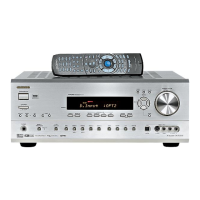Selecting an Audio Component
AUDIO SELECTOR
Selecting the type of audio input signal
Px-essthe AUDIO SELECTOR bullon on the front panel (or AUDIO
SEL bullon on the remole controller) to change the audio mode.
Each time the button is pressed, the mode changes from "Auto" -+
"Multich" (only ifDVD is selected as the input source) -->"Analog"
and back to ''Auto)'
TX-SR701/701E/601/601E
AUD_
SELEGTG_I
Remote controller
AUOK_8EL
Auto (automatic detection): With this setting, the TX-SR701/
701E/601/601E automatically detects whether the input signal is
digital or analog. When a digital signal is not input, then the analog
signal is played. This setting only appears if a digital input is
seleoed for the Digital Input setting at "Input Setup" --_ "Digital
Input" (see page 52).
Multich (Multichannel): Select this setting to play back the multi-
channel input from a DVD player with a 5A-channel input port.
Analog: Select this selling to play back the input fxom a source
component conneoed to analog audio input.jacks. With this selling,
even if a digital signal is input fxom the same component, only the
analog signal will be outpuL
Selecting the setting mode with the Cursor • /• button
while "Auto" appears
Auto: The digital signal suitable for the input signal will be
preceded for playback. When there is no digital signal input, analog
signal will be played.
DTS: Select this if you play DTS-formatted CD in "Auto" mode
and hear noise during fast-forward or rewind opera/ion. Non-DTS
sound input will not be output.
PCM: Select this if you heat sound gap between PCM tracks such
as ones on CD in "Auto" mode. Non-PCM sound input will not be
output.
Notes:
• When you play DTS-formatted CD or LD, be suxe to select
''Auto" or "DTS." If you select "PCM," noise will be heard.
• If a DTS signal is not input when "DTS" is selected, the TX-
SR701/701E/601/601E will not automatically switch to analog
output even though ''Auto" is selected with the AUDIO
SELECTOR button.
RCVR MODE
CH SEL
AUDIO SEL
LEVEL&IV
TAP
Notes on DTS:
If you play a DTS-formatted CD or LD when the "PCM"
setting is selected on the TX-SR701/701E/601/601E, the DTS
encoded signal will not be decoded and noise will be output.
This noise could damage the amplifier and speakers. Therefore,
be sure to select ''Auto" or "DTS" and use the digital input ,jacks
(OPT or COAX) to connect the DTS source.
• If you play a DTS-formatled CD or LD when "Auto" is
selected, you may heat a noise for a short while until the DTS
decoder recognizes the DTS-encoded signal and starts
opera/ing. This is not a malfunction,
• If you press the pause or skip button on the player while playing
a DTS source, a short noise may be heard. This is not a
malfunction. In such cases, try playing the source in the "DTS"
selected.
• The DTS indica/or on the TX-SR701/701E/601/6OIE lights
while a DTS source is played. When playback finishes and the
DTS signal transmission stops, the TX-SR701/701E/601/601E
remains in DTS mode and the DTS indicator remains lit. 'Ihis
prevents noise when you operate the pause or skip button on the
player. 'lhexefore, if the source is immediately swilched fx-om
DTS to PCM, the PCM signal may not be played. In this case,
stop the playback of the source on the player for about thxee
seconds and then resume playback.
• You may not be able to play some DTS source signals from
certain CD players and LD players even when you connect the
player to the TX-SR701/701E/601/601E digitally. This is
because the digital signal has been processed (such as the
output level, sampling frequency, or frequency response) and
the TX-SR701/701E/601/601E cannot recognize the signal as
DTS da/a. Therefore you may hear noise when you play a DTS
source while processing the signal.
The outputs for the VIDEO 1 OUT, VIDEO 2 OUT, and 'IAPE
OUT output analog audio signals. Do not record fxom CDs or
LDs that support DTS using these outputs. If you do, the DTS-
encoded signal will be recorded as noise.
• If a CD or LD encoded in the DTS format is played back with
"PCM" selecled, only noise will be produced. Always select
''Auto" or "DTS" when playing back DTS-encoded sources.
42

